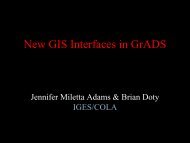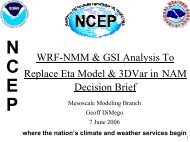The NCEP Climate Forecast System Reanalysis - NOAA National ...
The NCEP Climate Forecast System Reanalysis - NOAA National ...
The NCEP Climate Forecast System Reanalysis - NOAA National ...
Create successful ePaper yourself
Turn your PDF publications into a flip-book with our unique Google optimized e-Paper software.
As global prediction models have become increasingly more highly resolved and haveincluded more realistic boundary layer, water cycle and radiative parameterizations, thegenesis and evolution of tropical storms has dramatically improved. Equally importantare the ability of improved observing systems and analysis procedures to depict thedetails of tropical storm circulations and their accompanying steering flow.<strong>The</strong> first global reanalysis to assimilate historical tropical storm information was theJRA-25 reanalysis (Onogi, et.al. 2007). It assimilated synthetic wind profiles (Fiorino,2002) surrounding the historical storm locations of Newman, 1999.A unique feature of the CFSR is its approach to the analysis of historical tropical stormlocations. <strong>The</strong> CFSR applied the <strong>NCEP</strong> tropical storm relocation package (Liu et. al.,1999), a key component of the operational GFS analysis and prediction of tropical storm.By relocating a tropical storm vortex to its observed location prior to the assimilation ofstorm circulation observations, distortion of the circulation by the mismatch of guess andobserved locations is avoided. Fiorino (personal communication) provided the CFSRwith the historical set of storm reports converted into the operational format provided to<strong>NCEP</strong> by the <strong>NOAA</strong>/NWS <strong>National</strong> Hurricane Center and the US Navy Joint TyphoonWarning Center. Figure 28 shows the yearly total of tropical storm reports stacked by the8 geographical basins.A measure of the ability of assimilation to depict observed tropical storms is to quantifywhether or not a reported storm is detected in the assimilation guess. Figure 29 shows thetime series of the percentage of detected tropical storms plotted globally and for selectedNorthern Hemisphere basins: the Atlantic-Caribbean (ATL), the western Pacific (W Pac),and Eastern Pacific (E Pac). A noticeable improvement starts in 2000 coincident with thefull utilization of the ATOVS satellite instruments, such that between 90-95% of reportedtropical storms are detected.3.2 <strong>The</strong> Atmospheric <strong>Forecast</strong> Model<strong>The</strong> first <strong>NCEP</strong>/NCAR <strong>Reanalysis</strong> (R1, Kalnay et al., 1996; Kistler et al., 2001) was basedon the operational medium range forecast model of January 1995. R1 had a T62 horizontal- 23 -





